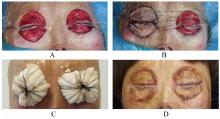| 1 |
SIDANA S, KADAM S. Cicatricial ectropion of lower eyelid: a report of two cases[J]. J Cutan Aesthet Surg, 2021, 14(2): 233-237.
|
| 2 |
JOVANOVIC N, DIZDAREVIC A, DIZDAREVIC N, et al. Case report of Wolfe grafting for the management of bilateral cicatricial eyelid ectropion following severe burn injuries[J]. Ann Med Surg, 2018, 34: 58-61.
|
| 3 |
SUBRAMANIAN N, NIVEAN P D, ALAM M S. Combined medical and surgical management for cicatricial ectropion in lamellar ichthyosis: a report of three cases[J].Indian J Ophthalmol,2020,68(11): 2615-2617.
|
| 4 |
王丹丹, 杨霖璟, 李晶晶, 等. 早期离子束透皮给药治疗瘢痕性睑外翻1例[J]. 中华整形外科杂志, 2022(2): 222-223.
|
| 5 |
BEHERA G, SANGARAJU S, MEETHALE THIRUVOTH F, et al. Vision and ocular surface salvage in extreme postburn cicatricial ectropion with infectious exposure keratitis[J]. J Burn Care Res, 2021, 42(4): 836-838.
|
| 6 |
ZUCAL I, WALDNER M, SHOJAATI G, et al. Burn scar ectropion correction: surgical technique for functional outcomes[J]. Ann Plast Surg, 2022, 88(3): 271-276.
|
| 7 |
MEDINA A. Management of severe multifactorial eyelid ectropion with lateral tarsal strip procedure and full-thickness skin graft[J]. Cureus, 2022, 14(3): e23462.
|
| 8 |
范海燕, 孙 英. 睑缘切口延伸皮瓣联合眼轮匝肌深层固定术矫正瘢痕性下睑外翻的临床观察[J]. 临床眼科杂志, 2021, 29(3): 244-246.
|
| 9 |
VAHDANI K, THALLER V T. Anterior lamellar deficit ectropion management[J]. Eye, 2021, 35(3): 929-935.
|
| 10 |
周英晋, 杜红岩, 姚 瑶, 等. 眼轮匝肌蒂皮瓣联合外眦锚着术治疗瘢痕性下睑外翻[J]. 中国美容整形外科杂志, 2019, 30(6): 370-372.
|
| 11 |
WANG F Y, CHENG J, ZHAI H L, et al. Correlation analysis of the clinical features and prognosis of acute ocular burns-exploration of a new classification scheme[J]. Albrecht Von Graefes Arch Fur Klin Und Exp Ophthalmol, 2020, 258(1): 147-155.
|
| 12 |
杜兴隆,江艳,方庆伟,等. 眼轮匝肌蒂皮瓣联合外眦锚着术对瘢痕性下睑外翻的治疗效果研究[J]. 医学美学美容, 2022, 31(6): 65-68.
|
| 13 |
WORLEY B, HUANG J W, MACDONALD J. Approach to treatment of cicatricial ectropion: a systematic review and meta-analysis comparing surgical and minimally invasive options[J]. Arch Dermatol Res, 2020, 312(3): 165-172.
|
| 14 |
ROMERO R, SANCHEZ-ORGAZ M, GRANADOS M, et al. Use of hyaluronic acid gel in the management of cicatricial ectropion: results and complications[J]. Orbit, 2013, 32(6): 362-365.
|
| 15 |
TANWAR V, PUSHKER N, AGRAWAL S, et al. Autologous fat grafting for the correction of cicatricial ectropion[J].J Plast Reconstr Aesthet Surg,2022,75(12): 4496-4512.
|
| 16 |
OUYANG H W, GOLD M H, LEI Y, et al. Laser therapy in the treatment of cicatricial ectropion[J]. J Cosmet Dermatol, 2021, 20(1): 84-92.
|
| 17 |
赵相宜, 郑 梁, 吴小蔚. 瘢痕性下睑外翻的治疗进展[J].中国美容整形外科杂志,2017,28(2):123-125.
|
| 18 |
MCKELVIE J, PAPCHENKO T, CARROLL S,et al. Cicatricial ectropion surgery: a prospective study of long-term symptom control, patient satisfaction and anatomical success[J].Clin Exp Ophthalmol,2018,46(9): 1002-1007.
|
| 19 |
曾 妍, 范金财. 瘢痕性下睑外翻的外科治疗进展[J]. 中国美容医学, 2019, 28(9): 160-164.
|
| 20 |
KOOISTRA LAURA J, SCOTT JEFFREY F, BORDEAUX JEREMY S. Cicatricial ectropion repair for dermatologic surgeons[J]. Dermatol Surg, 2020, 46(3): 341-347.
|
| 21 |
DING J, LIU C, CUI J, et al. Efficacy of pre-expanded forehead flap based on the superficial temporal artery in correction of cicatricial ectropion of the lower eyelid[J]. Br J Oral Maxillofac Surg, 2021, 59(1): 58-63.
|
| 22 |
YAN Y X, FU R, JI Q M, et al. Surgical strategies for eyelid defect reconstruction: a review on principles and techniques[J]. Ophthalmol Ther, 2022, 11(4): 1383-1408.
|
| 23 |
LOUCA M, DUSSELDORP J R. A patient with traumatic upper eyelid ectropion and their management by canthopexy[J]. J Craniofac Surg, 2021,32(3): e271-e273.
|
| 24 |
MOL I, PARIDAENS D. Efficacy of lateral eyelid-block excision with canthoplasty and full-thickness skin grafting in lower eyelid cicatricial ectropion[J]. Acta Ophthalmol, 2019, 97(4): e657-e661.
|
| 25 |
CHRISTENSEN J M, SHANBHAG S S, SHIH G C, et al. Multidisciplinary treatment to restore vision in ocular burns[J]. J Burn Care Res,2020,41(4): 859-865.
|
| 26 |
JOETHY J, TAN B K. A multi-staged approach to the reconstruction of a burnt Asian face[J]. Indian J Plast Surg, 2011, 44(1): 142-146.
|
| 27 |
MALHOTRA R, SHEIKH I, DHEANSA B. The management of eyelid burns[J]. Surv Ophthalmol, 2009, 54(3): 356-371.
|
| 28 |
RATHORE D S, CHICKADASARAHILLI S, CROSSMAN R, et al. Full thickness skin grafts in periocular reconstructions: long-term outcomes[J]. Ophthalmic Plast Reconstr Surg, 2014, 30(6): 517-520.
|
| 29 |
方 涛, 张永升, 李鸿强. 上睑双蒂肌皮瓣在瘢痕性下睑外翻修复中的应用效果分析[J]. 中国美容医学, 2022, 31(5): 82-85.
|
 )
)









